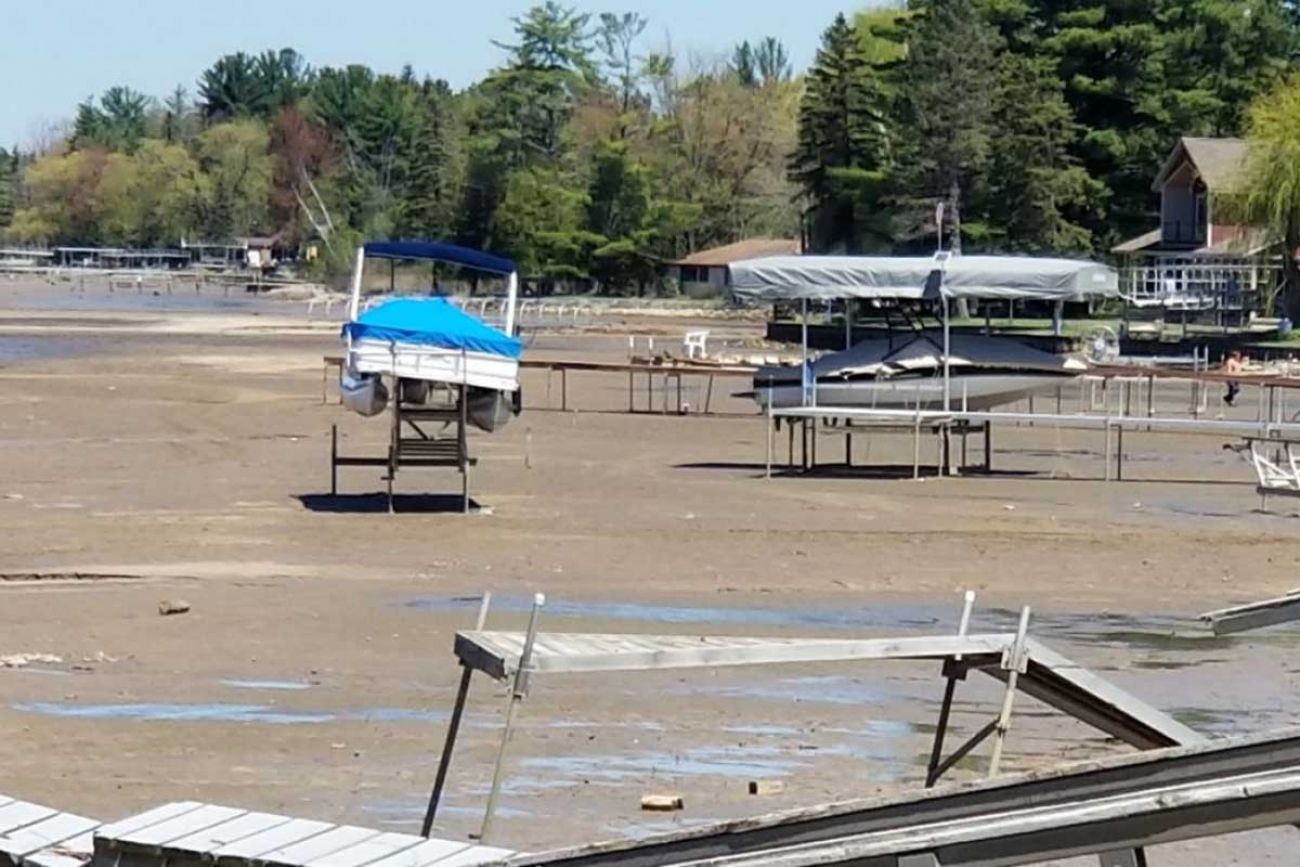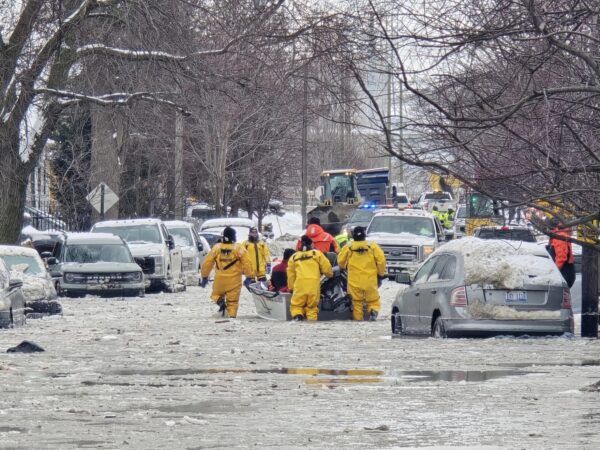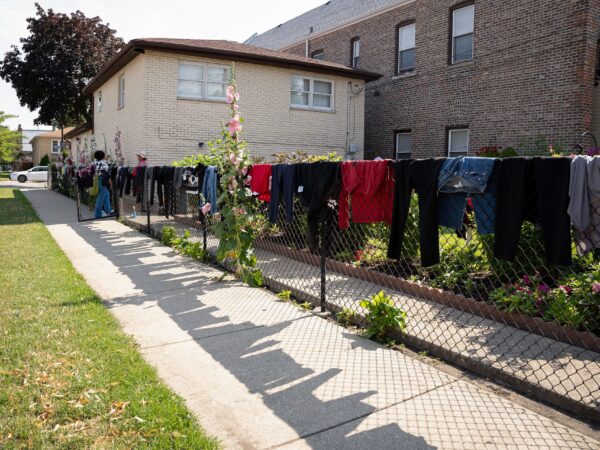
By Kelly House, Bridge Michigan
The Great Lakes News Collaborative includes Bridge Michigan; Circle of Blue; Great Lakes Now at Detroit Public Television; and Michigan Radio, Michigan’s NPR News Leader; who work together to bring audiences news and information about the impact of climate change, pollution, and aging infrastructure on the Great Lakes and drinking water. This independent journalism is supported by the Charles Stewart Mott Foundation. Find all the work HERE.
The mid-Michigan dam failures in 2020 were “foreseeable and preventable,” if only pretty much anyone involved in the Edenville Dam’s century-long lifespan had recognized and acted upon its shoddy construction and the potential that extreme floodwaters would punch a hole through its embankment.
That’s one takeaway from a five-member independent forensic team tasked with investigating the physical and human causes of the May 2020 dam failures at Edenville and the downstream Sanford Dam near Midland, which flooded out mid-Michigan, causing more than $200 million in property damage and forcing more than 10,000 people to evacuate.
The Association of State Dam Safety Officials released the investigative team’s final report Wednesday. Investigators declined to place blame at the foot of any one person or group.
Instead, investigators wrote, “it was the overall system for financing, designing, constructing, operating, evaluating, and upgrading the four dams, involving many parties during the nearly 100 years of project history, which fell short in ensuring a safe dam at the Edenville site.”
But investigators made clear that the Edenville failure would “almost certainly have been prevented” if someone had addressed deficiencies to its spillway that federal regulators had first flagged decades before the May 2020 disaster.
Michigan legislators and Gov. Gretchen Whitmer last month approved $200 million in public funds to help restore Edenville and three other dams damaged in the 2020 floods.
Katelyn Riley, a spokesperson for the dam association, said the group expects “vital lessons to be learned.”
“The next steps for us will be to make sure these messages are widely distributed and understood by the profession,” Riley said. “We have full confidence in the ability of the team and the accuracy of (its) findings.”
The organization has planned a Q&A session Thursday afternoon to answer journalists’ questions.
The Federal Energy Regulatory Commission, which oversaw the Edenville Dam for most of its history, had been trying for decades to get dam owner Boyce Hydro and its predecessors to upgrade spillways at the dam. Those structures, which can be adjusted to control the flow of water through a dam when a reservoir fills, were not big enough to pass the “probable maximum flood” in the area surrounding Edenville.
When the dam’s owner, Boyce Hydro, claimed it lacked money to expand the spillways, FERC’s primary enforcement options were financial penalties, draining the reservoir behind the dam, or revoking Boyce’s license to generate power — all of which investigators concluded would have exacerbated Boyce’s funding problem.
FERC ultimately chose option three in September 2018. That abruptly shifted oversight to a state regulatory system where spillway flood control standards are half as stringent. Regulators at the Michigan Department of Environment, Great Lakes and Energy (EGLE) also had “very limited information about the dam,” and struggled to obtain needed information from FERC, investigators noted.
The state had only recently discerned that the Edenville Dam met Michigan’s lower safety standards when the dam failed in May 2020.
Celeste Miller, a spokesperson for FERC, said the agency takes dam safety issues “very seriously” and has adopted a range of dam safety reforms since the mid-Michigan failures.
Hugh McDiarmid, a spokesperson for the Michigan Department of Environment, Great Lakes and Energy, issued a statement Wednesday saying the agency is reviewing the findings.
“EGLE looks forward to using these resources and the findings of the IFT’s report to work with local, state and federal partners and policymakers further strengthen oversight of and assistance to the 1,000-plus dams the state regulates,” McDiarmid wrote.
Investigators revealed in a preliminary report last fall that the Edenville dam failed after intense floodwaters raised the water level behind the dam, waterlogging its loose-sand embankment and causing it to liquify under the pressure of the water backed up behind it. Floodwaters from that failure triggered a subsequent failure downstream at the Sanford Dam.
At the root of that failure, investigators said in that earlier report, was shoddy construction dating back to when the dam was built in 1925.
Wednesday’s subsequent report illuminates how construction failures went unnoticed for 95 years: During FERC’s decades-long oversight of the dam, its embankment was analyzed in two different locations. But those pinpoint analyses did not focus on the section that eventually failed.
Had that section been analyzed, investigators wrote, it would likely have resulted in “embankment modifications” that would have prevented the failure.
Meanwhile, dam safety officials at both FERC and, later, EGLE were more focused on whether the dams met regulatory requirements than whether they could withstand “a range of possible floods and their associated risks.”
The rainstorm that caused the Edenville failure wasn’t all that extreme — a once in 25 to 50-year event. But soils were already saturated, causing water to pour into rivers rather than seeping into the ground. That filled the dam as fast as a once-in-100 to 200-year rainstorm.
At the time of failure, lake levels behind Edenville Dam were three feet higher than any time in the dam’s history. Yet the spillway gates through which water exits the dam were not fully opened because Boyce’s engineering consultants feared that opening them further would damage the gates and compromise operator safety.
And even when opened wide, those gates remained too small to pass the “probable maximum flood” that could be expected in mid-Michigan.
Investigators said in their report Wednesday that fixing the too-small spillway early enough to prevent the dam failure would have required more cooperation and earlier action by a host of parties – none of whom had much incentive to do things differently.
FERC’s decision to revoke Boyce’s power generation license over the spillway issues, investigators wrote, had a “net negative effect from a dam safety standpoint,” because not only could Boyce no longer generate revenue from selling electricity generated at the dams, it could not release water through the dam’s powerhouse.
Had such a release been possible during the May 2020 flood, investigators said, lake levels would have been up to 0.8 feet lower at the time of Edenville’s failure, which “may or may not” have prevented the failure.
Investigators concluded that, “with the benefit of hindsight,” FERC should not have revoked Edenville’s license. Instead, investigators wrote, the agency should have worked with Boyce and the Four Lakes Task Force, a group representing lakeside property owners, to craft a plan for fixing the spillway.
Since the failure, the independent review team and a state task force have recommended a host of reforms to state law, policy and funding to better prevent future failures. Many of those recommendations have yet to be addressed.
The Legislature has boosted EGLE’s dam safety funding, allowing the agency to double staffing within its dam safety unit and allocating $41 million for a grant and loan program to reduce risks at other Michigan dams.
In their Wednesday report, the investigative team offered several more pieces of advice in hopes of preventing future failures. Among them:
- The physical dam inspections commonly used by dam safety regulators “are not sufficient by themselves to identify risks and manage safety.” Dam regulators also should periodically review dam construction and designs, maintenance records and other data on high-hazard dams. New FERC rules that took effect last month will include such reviews. Michigan has no such requirements.
- Federal, state and local governments should provide more financial help for cash-strapped dam owners who can’t afford to fix their dams.
- The people who benefit from dams — in Edenville’s case, lakeside landowners, local governments and others who enjoy higher property values, increased tax revenue and more recreational opportunities because they live near reservoirs that have become recreational lakes — should help foot the bill to maintain them.
- FERC needs authority to order a “breach” — punching a hole in the dam to make it incapable of holding water — if the owner can’t pay to fix an unacceptable safety risk. EGLE has such authority from the state, inspectors wrote, but “at the time of the failure, EGLE had been the regulator of Edenville Dam for only a short time, and the agency was still evaluating the dam and had not developed a basis for considering a breach.”
In the end, investigators concluded, residents downstream of the dam, who enjoyed few benefits from its recreational lake yet bore the most risk from a failure, were the “innocent victims” when the floodwaters breached Edenville.
Catch more news at Great Lakes Now:
Should taxpayers foot the bill for restoring the Midland dams?
Legal Responsibility: Michigan lawsuit blames dam owner for Midland dam failure
Featured image: The final report, by the Association of State Dam Safety Officials, outlines nearly 100 years of missed opportunities to anticipate safety issues before the disaster that emptied Sanford Lake (above) (Bridge file photo)




